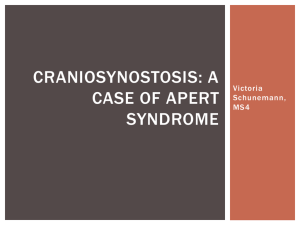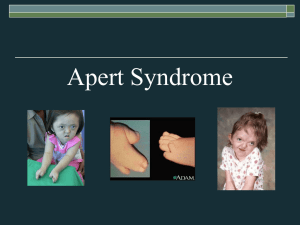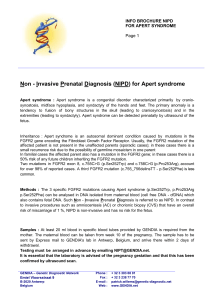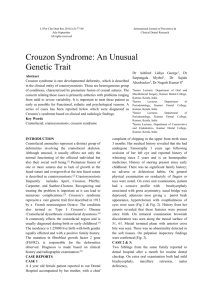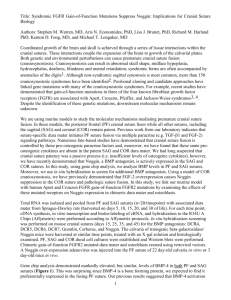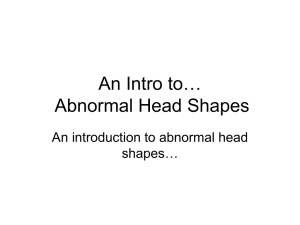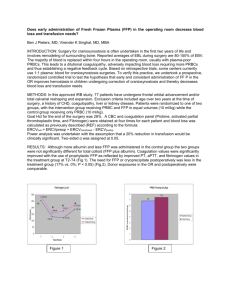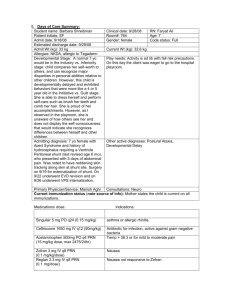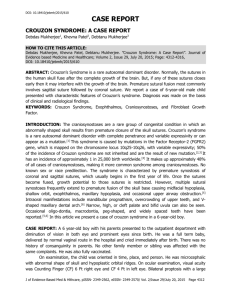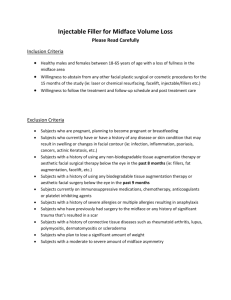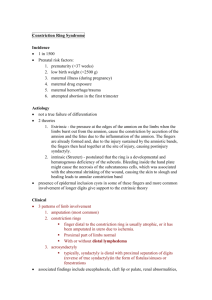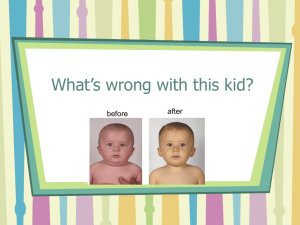Syndromic Craniosynostosis
advertisement
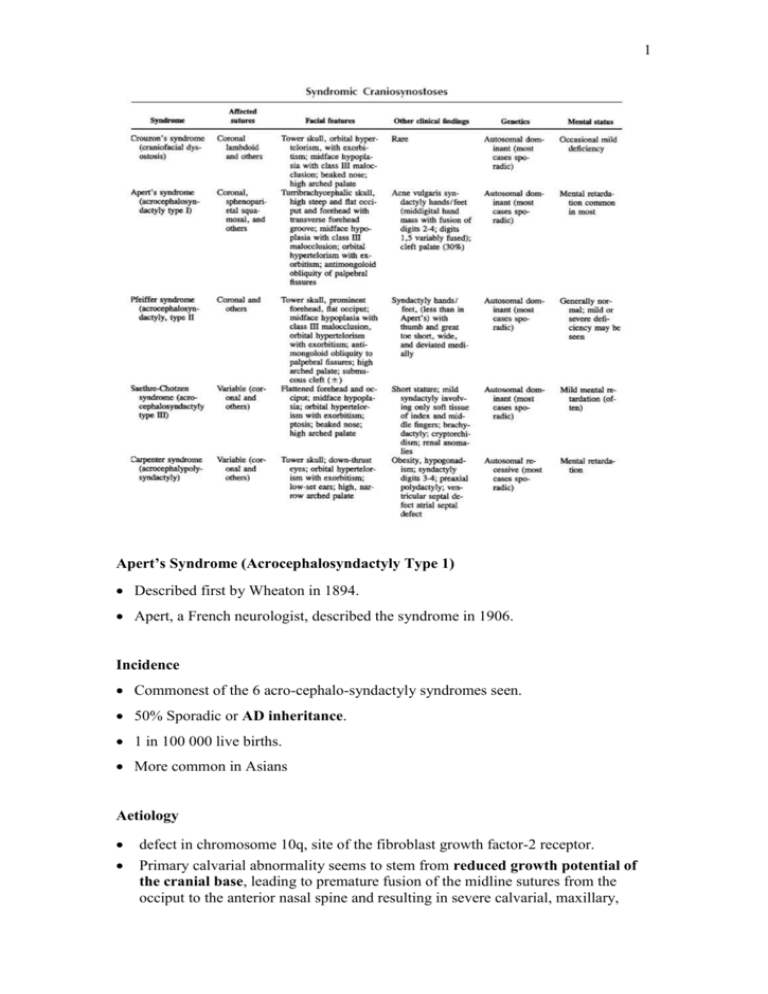
1 Apert’s Syndrome (Acrocephalosyndactyly Type 1) Described first by Wheaton in 1894. Apert, a French neurologist, described the syndrome in 1906. Incidence Commonest of the 6 acro-cephalo-syndactyly syndromes seen. 50% Sporadic or AD inheritance. 1 in 100 000 live births. More common in Asians Aetiology defect in chromosome 10q, site of the fibroblast growth factor-2 receptor. Primary calvarial abnormality seems to stem from reduced growth potential of the cranial base, leading to premature fusion of the midline sutures from the occiput to the anterior nasal spine and resulting in severe calvarial, maxillary, 2 nasal, and mandibular abnormalities. Has been noted that severity of hand defect is inversely related to craniofacial defect - This has now been documented to be due to defects in different loci within the FGFR2 gene (PRS Jan 2005) - syndactyly of Apert syndrome is a keratinocyte growth factor receptor (KGFR)-mediated effect was provided by the observation of the correlation between KGFR expression in fibroblasts and severity of syndactyly. - Patients with Ser252Trp and those with Pro253Arg have different phenotypic expression. The syndactyly is more severe with Pro253Arg mutation for both hands and feet, whereas cleft palate ( a marker of craniofacial severity) is significantly more common with Ser252Try mutation Features 1) Craniosynostosis: typically brachycephalic, may progress to turricephaly. 2) fontanelles may be large and late in closing 3) Exorbitism, hypertelorism, antimongoloid slant, ocular muscle palsy 4) Midface hypoplasia: flat facies 5) palate is narrow and either has a median groove or is cleft with a bifid uvula 6) Symmetrical syndactyly of the hands and feet 7) moderate to severe facial and upper extremity acne. 8) Mental retardation(50%): some patients attain a high level of mental function. 3 Early complications 1. Headache and vomiting - acute increased intracranial pressure 2. Stridor and sleep apnea indicate problems with the upper airway, resulting from craniosynostosis of sutures of the base of the skull. 3. Globe exposure with exorbitism 4. Feeding difficulties with cleft palate Crouzon’s Disease Craniosynostosis with a frog-like face. Exorbitism retrusion/hypoplasia are prominent features Incidence AD with almost complete penetrance. Most are sporadic. 1 in 25,000 No association with other congenital defects. Aetiology Defect mapped to the FGFR2 gene and midface 4 Features 1. No regular pattern of calvarial deformity: scaphocephaly, trigonocephaly or oxycephaly can be present depending on the site of craniosynostosis. Coronal, sagittal and lambloid sutures have all been found to be prematurely fused. 2. recession of the frontal bone and supraorbital rim, retrusion of the facial mass 3. exorbitism with proptosis, divergent strabismus (over-activity the inferior rectus muscle, hypertelorism 4. hypoplasia of the infraorbital rim, distention of the eyelids 5. palpebral fissures slanted downward 6. usually develop normal intelligence 7. limb anomalies are absent. The shape of the skull does not differentiate Apert’s and Crouzon’s. Differences between Crouzon’s and Apert’s (Kreiborg) Kreiborg recently used 3D CT to differentiate and compare the anatomy of the two. Very different cranial development. In Apert’s, cartilage abnormalities, especially of the cranial base, play a role cranial development. In Crouzon’s, premature fusion and synostosis is of primary importance. Early surgery is advocated for both but for different reasons: In Apert’s, early surgery is indicated to further dysmorphic growth changes in the cranial base. In Crouzon’s, early surgery is indicated for RICP. Pfeiffer’s Syndrome (Acrocephalosyndactyly Type II) Tessier refers to it as “low Apert’s”. AD, sporadic (mostly) and inherited forms 5 Mutations in FGFR1 and FGFR2 Features: 1) Craniosynostosis as for Crouzon’s and Apert’s: frontal bossing, etc. 2) broad thumbs and great toes, often medially deviated - pathognomonic 3) Variable exorbitism 4) Midface hypoplasia as for Apert’s but cranial synostosis not as severe 5) IQ normal Carpenter’s Syndrome (Acrocephlopolysyndactyly) AR one of the few to be AR. Mutation in FGFR2 Features 1) Craniosynostosis: pansynostosis with brachycephaly approaching Kleeblattschadel 2) Midfacial retrusion and dental malocclusion are less pronounced than in Apert’s, 3) Variable soft tissue syndactyly of hands and feet, short digits, preaxial polydactyly. 4) syndactyly is only partial and usually simple. 5) Congenital heart disease, hypogenitalism, obesity, umbilical hernia. 6) Intellectual impairment in 75% Poole cautions surgeons contemplating surgery on patients with Carpenter’s syndrome that they must beware of the venous and bony abnormalities attendant with this syndrome. The vascular anomalies may lead to excessive and rapid blood loss. Saethre-Chotzen Syndrome (Acrocephalosyndactyly Type III) 1 in 25,000-50,000 AD with full penetrance. Mutation in TWIST gene in 68%, FGRR2 and FGFR3 described Features: 6 1) Craniosynostosis – bicoronal synostosis 2) Low hairline 3) Upper eyelid ptosis 4) Deviated nasal septum 5) Brachysyndactyly (less severe than in Apert’s) - partial cutaneous or simple syndactyly, usually between the second and third fingers but sometimes involving the small finger too. 6) Normal IQ Mild exorbitism is associated with retrusion of brow or supraorbital rim. The midface is usually normal, which led Tessier to call it “upper Apert.”
